Investigation of a Camera-Based Contactless Pulse Oximeter with Time-Division Multiplex Illumination Applied on Piglets for Neonatological Applications
Abstract
:1. Introduction
2. Materials and Methods
2.1. Pulse Oximetry
2.2. Signal Processing
- Display a default image of the recorded scene, in which a suitable place for the sub-AOI (125 px)² is selected.
- Rework each image with a 2D Hann window to filter light movement. The Hann window is parameterized in a manner that the window function obtains zero at the edge of the window with px. Pixels close to the edges are weighted less than in the center.
- Perform weighted averaging of all pixels based on the 2D Hann window to one intensity value. Thus, the given quantization is increased from 10 bits by 7 bits to 17 bits (compare the oversampling effect) in amplitude. Due to the effect that the quantization introduces uniformly distributed noise with a level of , this noise is reduced by averaging under the assumption that the noise in each pixel is independent from other pixels. The variations due to heartbeat are comparable in each pixel; thus, averaging does not influence the level of the heartbeat signal. Without this virtual increase, the heartbeat signal cannot be reliably detected because it is in the range of the noise level.
- Sort the discrete time values to match the corresponding spectral component.
- Subtract the black value from each signal to remove constant background lighting.
- (A) Average the weighted window of a length of 12 s to obtain DC.(B) Subtract the DC value in the current time window and thus determine the AC part of the signal.
- Adjust spectral components in the phase by multiplying with , where corresponds to and n is the corresponding timestamp in each multiplex phase starting with zero.
- Rework the last 12 s of the signal with a window function to obtain a periodic signal.
- Transform each window (12 s) from the time domain into the frequency domain by a fast Fourier transformation including zero padding to obtain a length of 8192 points.
- Classify the pulse signal in .
- Calculate the ratio of ratio.
- Calculate oxygen saturation according to Equation (12).
2.3. Camera
2.4. Microcontroller and Illumination
3. Experimental Setup
4. Results
4.1. Skin Pulse Rate and Respiratory Rate
4.2. Oxygen Saturation
5. Discussion
5.1. Skin Pulse Rate and Respiratory Rate
5.2. Oxygen Saturation
6. Conclusions
Author Contributions
Funding
Institutional Review Board Statement
Data Availability Statement
Acknowledgments
Conflicts of Interest
Abbreviations
| AC | Alternating current; here, the time-varying signal part |
| AOI | Area of- nterest |
| AOP | Apnea of prematurity |
| bpm | Beats per minute |
| CLK | Clock |
| ECG | Electrocardiography |
| DC | Direct current; here, the time-constant signal part |
| dB | Decibel |
| GE | General Electric |
| GUI | Graphical user interface |
| GPIO | General purpose input output |
| Hb | Deoxyhemoglobin |
| HbO2 | Oxyhemoglobin |
| IDS | Imaging Development Systems GmbH |
| LED | Light-emitting diode |
| MAE | Mean absolute error |
| C | Microcontroller |
| NICU | Neonatal intensive care unit |
| PO | Pulse oximetry |
| px | Pixel |
| RGB | red–green–blue color space |
| RMSE | Root mean squared error |
| rPPG | Remote photoplethysmography |
| PPG | Photoplethysmography |
| SpO2 | Oxygen saturation |
| USB | Universal serial bus |
References
- Purisch, S.E.; Gyamfi-Bannerman, C. Epidemiology of preterm birth. Semin. Perinatol. 2017, 41, 387–391. [Google Scholar] [CrossRef] [PubMed]
- Goedicke-Fritz, S.; Hartel, C.; Krasteva-Christ, G.; Kopp, M.V.; Meyer, S.; Zemlin, M. Preterm Birth Affects the Risk of Developing Immune-Mediated Diseases. Front. Immunol. 2017, 8, 1266. [Google Scholar] [CrossRef] [PubMed]
- Glass, H.C.; Costarino, A.T.; Stayer, S.A.; Brett, C.M.; Cladis, F.; Davis, P.J. Outcomes for extremely premature infants. Anesth. Analg. 2015, 120, 1337–1351. [Google Scholar] [CrossRef] [PubMed]
- Chung, H.U.; Kim, B.H.; Lee, J.Y.; Lee, J.; Xie, Z.Q.; Ibler, E.M.; Lee, K.; Banks, A.; Jeong, J.Y.; Kim, J.; et al. Binodal, wireless epidermal electronic systems with in-sensor analytics for neonatal intensive care. Science 2019, 363, 6430. [Google Scholar] [CrossRef] [PubMed]
- Cartlidge, P.H.; Fox, P.E.; Rutter, N. The scars of newborn intensive care. Early Hum. Dev. 1990, 21, 1–10. [Google Scholar] [CrossRef]
- Ranger, M.; Grunau, R.E. Early repetitive pain in preterm infants in relation to the developing brain. Pain Manag. 2014, 4, 57–67. [Google Scholar] [CrossRef]
- Aoyagi, T. Improvement of the earpiece oximeter. In Abstracts of the Japanese Society of Medical Electronics and Biological Engineering; Japanese Society of Medical Electronics and Biological Engineering: Tokyo, Japan, 1974; pp. 90–91. [Google Scholar]
- Poets, C.F.; Southall, D.P. Noninvasive monitoring of oxygenation in infants and children: Practical considerations and areas of concern. Pediatrics 1994, 93, 737–746. [Google Scholar] [CrossRef]
- Aarts, L.A.; Jeanne, V.; Cleary, J.P.; Lieber, C.; Nelson, J.S.; Bambang Oetomo, S.; Verkruysse, W. Non-contact heart rate monitoring utilizing camera photoplethysmography in the neonatal intensive care unit—A pilot study. Early Hum. Dev. 2013, 89, 943–948. [Google Scholar] [CrossRef]
- Liu, C.; Correia, R.; Ballaji, H.K.; Korposh, S.; Hayes-Gill, B.R.; Morgan, S.P. Optical Fibre-Based Pulse Oximetry Sensor with Contact Force Detection. Sensors 2018, 18, 3632. [Google Scholar] [CrossRef]
- Barker, S.J. ”Motion-resistant” pulse oximetry: A comparison of new and old models. Anesth. Analg. 2002, 95, 967–972. [Google Scholar]
- Grooby, E.; Sitaula, C.; Chang, K.T.; Sharkey, D.; Marzbanrad, F.; Malhotra, A. Artificial intelligence-driven wearable technologies for neonatal cardiorespiratory monitoring: Part 1 wearable technology. Pediatr. Res. 2023, 93, 413–425. [Google Scholar] [CrossRef] [PubMed]
- Sivanandan, S. Wearables—A Revolution in Neonatal Monitoring? Indian J. Pediatr. 2023, 90, 1075–1076. [Google Scholar] [CrossRef] [PubMed]
- Zhou, L.; Guess, M.; Kim, K.R.; Yeo, W.-H. Skin-interfacing wearable biosensors for smart health monitoring of infants and neonates. Commun. Mater. 2024, 5, 72. [Google Scholar] [CrossRef]
- Pirzada, P.; Wilde, A.; Harris-Birtill, D. Remote Photoplethysmography for Heart Rate and Blood Oxygenation Measurement: A Review. IEEE Sensors J. 2024, 24, 23436–23453. [Google Scholar] [CrossRef]
- Svoboda, L.; Sperrhake, J.; Nisser, M.; Taphorn, L.; Proquitté, H. Contactless assessment of heart rate in neonates within a clinical environment using imaging photoplethysmography. Front. Pediatr. 2024, 12, 1383120. [Google Scholar] [CrossRef]
- Svoboda, L.; Sperrhake, J.; Nisser, M.; Zhang, C.; Notni, G.; Proquitté, H. Contactless heart rate measurement in newborn infants using a multimodal 3D camera system. Front. Pediatr. 2022, 10, 897961. [Google Scholar] [CrossRef]
- Prahl, S. Tabulated Molar Extinction Coefficient for Hemoglobin in Water. Available online: https://omlc.org/spectra/hemoglobin/summary.html (accessed on 7 September 2024).
- Wieringa, F.P.; Mastik, F.; van der Steen, A.F. Contactless multiple wavelength photoplethysmographic imaging: A first step toward ”SpO2 camera” technology. Ann. Biomed. Eng. 2005, 33, 1034–1041. [Google Scholar] [CrossRef] [PubMed]
- Aoyagi, T. Pulse oximetry: Its invention, theory, and future. J. Anesth. 2003, 17, 259–266. [Google Scholar] [CrossRef]
- Severinghaus, J.W. Takuo Aoyagi: Discovery of pulse oximetry. Anesth. Analg. 2007, 105, S1–S4. [Google Scholar] [CrossRef]
- Verkruysse, W.; Bartula, M.; Bresch, E.; Rocque, M.; Meftah, M.; Kirenko, I. Calibration of Contactless Pulse Oximetry. Anesth. Analg. 2017, 124, 136–145. [Google Scholar] [CrossRef]
- Humphreys, K.G. An Investigation of Remote Non-Contact Photoplethysmography and Pulse Oximetry. Ph.D. Thesis, Department of Electronic Engineering Faculty of Science and Engineering, National University of Ireland Maynooth, Maynooth, Ireland, 2007. [Google Scholar]
- Hülsbusch, M. Ein bildgestüTztes, Funktionelles Verfahren zur Optoelektronischen Erfassung der Hautperfusion. Ph.D. Thesis, Fakultät für Elektrotechnik und Informationstechnik, Rheinisch-Westfälische Tehnische Hochschule Aachen, Aachen, Germany, 2008. [Google Scholar]
- Wieringa, F.P. Pulse Oxigraphy: And Other New In-Depth Perspectives through the Near Infrared Window. Ph.D. Thesis, Erasmus Universiteit Rotterdam, Rotterdam, The Netherlands, 2007. [Google Scholar]
- Phattraprayoon, N.; Sardesai, S.; Durand, M.; Ramanathan, R. Accuracy of pulse oximeter readings from probe placement on newborn wrist and ankle. J. Perinatol. 2012, 32, 276–280. [Google Scholar] [CrossRef]
- Safar, H.; El-dash, H. Pulse Oximetry: Could Wrist and Ankle Be Alternative Placement Sites? Clin. Pediatr. 2015, 54, 1375–1379. [Google Scholar] [CrossRef] [PubMed]
- Nijland, R.; Nierlich, S.; Jongsma, H.W.; Nijhuis, J.G.; Oeseburg, B.; Springer, K.; Mannheimer, P. Validation of reflectance pulse oximetry: An evaluation of a new sensor in piglets. J. Clin. Monit. 1997, 13, 43–49. [Google Scholar] [CrossRef] [PubMed]
- Tarassenko, L.; Villarroel, M.; Guazzi, A.; Jorge, J.; Clifton, D.A.; Pugh, C. Non-contact video-based vital sign monitoring using ambient light and auto-regressive models. Physiol. Meas. 2014, 35, 807–831. [Google Scholar] [CrossRef] [PubMed]
- Sun, Y.; Papin, C.; Azorin-Peris, V.; Kalawsky, R.; Greenwald, S.; Hu, S. Use of ambient light in remote photoplethysmographic systems: Comparison between a high-performance camera and a low-cost webcam. J. Biomed. Opt. 2012, 17, 037005. [Google Scholar] [CrossRef] [PubMed]
- Kong, L.; Zhao, Y.; Dong, Y.; Jian, Y.; Jin, X.; Li, B.; Feng, Y.; Liu, M.; Liu, X.; Wu, H. Non-contact detection of oxygen saturation based on visible light imaging device using ambient light. Opt. Express 2013, 21, 17464–17471. [Google Scholar] [CrossRef] [PubMed]
- Karlen, W.; Lim, J.; Ansermino, J.M.; Dumont, G.; Scheffer, C. Design challenges for camera oximetry on a mobile phone. In Proceedings of the 2012 Annual International Conference of the IEEE Engineering in Medicine and Biology Society, San Diego, CA, USA, 28 August–1 September 2012; pp. 2448–2451. [Google Scholar]
- Kellicut, D.C.; Weiswasser, J.; Arora, S.; Freeman, J.; Lew, R.; Shuman, C.; Mansfield, J.; Sidawy, A. Emerging technology: Hyperspectral imaging. Perspect. Vasc. Surg. Endovasc. Ther. 2004, 16, 53–57. [Google Scholar] [CrossRef]
- Eisenhauer, C.L.; Matsuda, L.S.; Uyehara, C. Normal physiologic values of neonatal pigs and the effects of isoflurane and pentobarbital anesthesia. Lab. Anim. Sci. 1994, 44, 245–252. [Google Scholar]
- Du Sert, P.N.; Ahluwalia, A.; Alam, S.; Avey, M.T.; Baker, M.; Browne, W.J.; Clark, A.; Cuthill, I.C.; Dirnagl, U.; Emerson, M.; et al. Reporting animal research: Explanation and elaboration for the ARRIVE guidelines 2.0. PLoS Biol. 2020, 18, e3000411. [Google Scholar] [CrossRef]
- Voigt, M.; Wittwer-Backofen, U.; Scholz, R.; Schneider, K.T.; Straube, S.; Olbertz, D.; Hesse, V.; Rochow, N. Analysis of the German perinatal survey of the years 2007–2011 and comparison with data from 1995–1997: Neonatal characteristics and duration of pregnancy. Z. Geburtshilfe Neonatol. 2013, 217, 211–214. [Google Scholar] [CrossRef]
- Brew, N.; Walker, D.; Wong, F.Y. Cerebral vascular regulation and brain injury in preterm infants. Am. J. Physiol. Regul. Integr. Comp. Physiol. 2014, 306, R773–R786. [Google Scholar] [CrossRef] [PubMed]
- Chau, V.; McFadden, D.E.; Poskitt, K.J.; Miller, S.P. Chorioamnionitis in the pathogenesis of brain injury in preterm infants. Clin. Perinatol. 2014, 41, 83–103. [Google Scholar] [CrossRef] [PubMed]
- Bonan, K.C.; Pimentel Filho, J.C.; Tristao, R.M.; Jesus, J.A.; Campos Junior, D. Sleep deprivation, pain and prematurity: A review study. Arq. Neuropsiquiatr. 2015, 73, 147–154. [Google Scholar] [CrossRef]
- Onyeama, C.O.; Srinivasan, H.; Lotke, M.; Vickers, D.L. Subgaleal abscess and E. coli septicemia following scalp electrode in a preterm newborn: A case report. J. Mater. Fetal Neonatal. Med. 2009, 22, 1201–1203. [Google Scholar] [CrossRef]
- Rogdo, B.; Kahlert, C.; Diener, P.A.; Micallef, J. Primary cutaneous aspergillosis in a preterm neonate. BMJ Case Rep. 2014, 2014, bcr2014204752. [Google Scholar] [CrossRef] [PubMed]
- Langton, J.A.; Hanning, C.D. Effect of motion artefact on pulse oximeters: Evaluation of four instruments and finger probes. Br. J. Anaesth. 1990, 65, 564–570. [Google Scholar] [CrossRef]
- Severinghaus, J.W.; Spellman, M.J. Pulse oximeter failure thresholds in hypotension and vasoconstriction. Anesthesiology 1990, 73, 532–537. [Google Scholar] [CrossRef]
- Villanueva, R.; Bell, C.; Kain, Z.N.; Colingo, K.A. Effect of peripheral perfusion on accuracy of pulse oximetry in children. J. Clin. Anesth. 1999, 11, 317–322. [Google Scholar] [CrossRef]
- Adler, J.N.; Hughes, L.A.; Vivilecchia, R.; Camargo, C.A. Effect of skin pigmentation on pulse oximetry accuracy in the emergency department. Acad. Emerg. Med. 1998, 5, 965–970. [Google Scholar] [CrossRef]
- Amar, D.; Neidzwski, J.; Wald, A.; Finck, A.D. Fluorescent light interferes with pulse oximetry. J. Clin. Monit. 1989, 5, 135–136. [Google Scholar] [CrossRef]

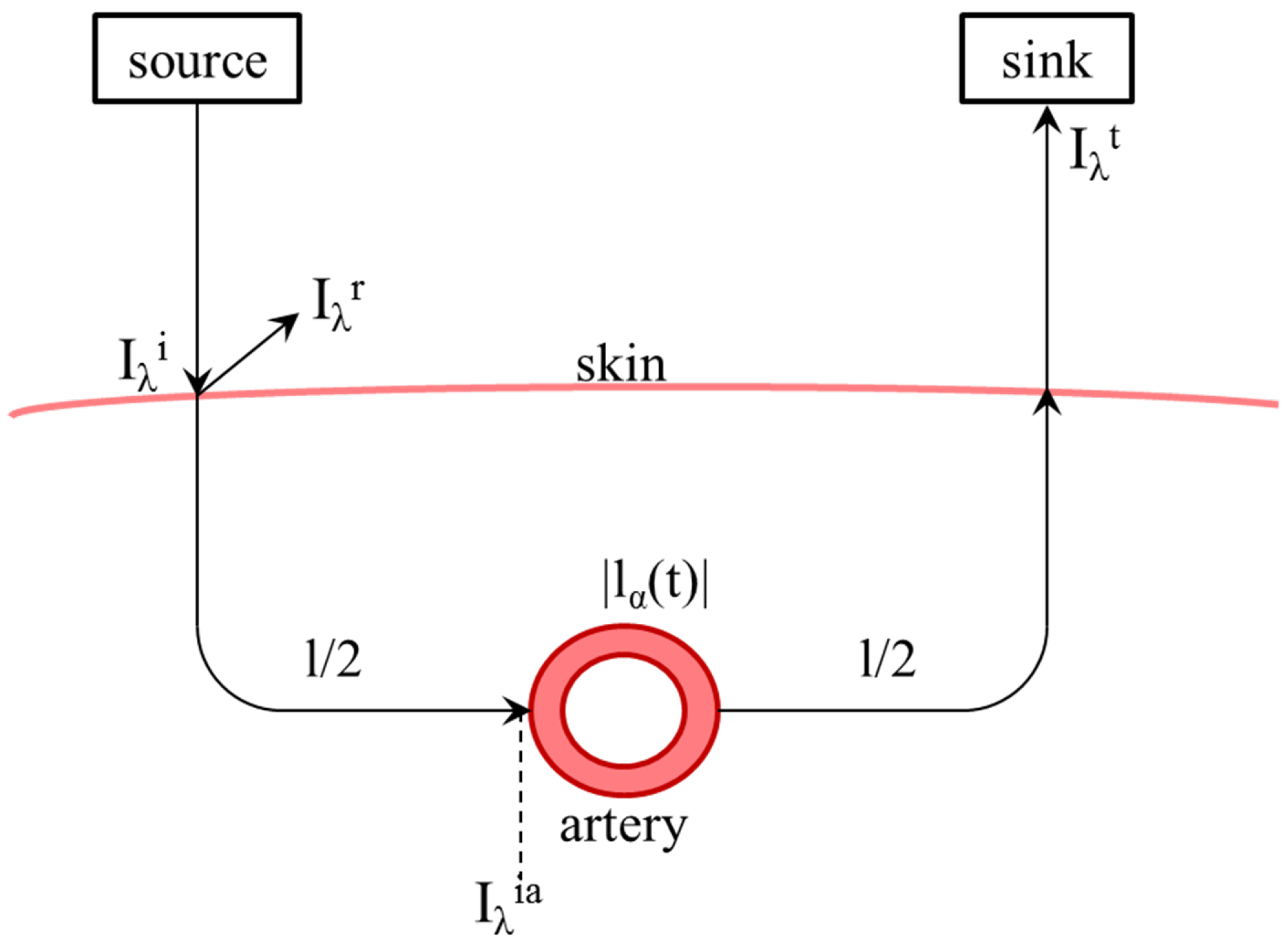
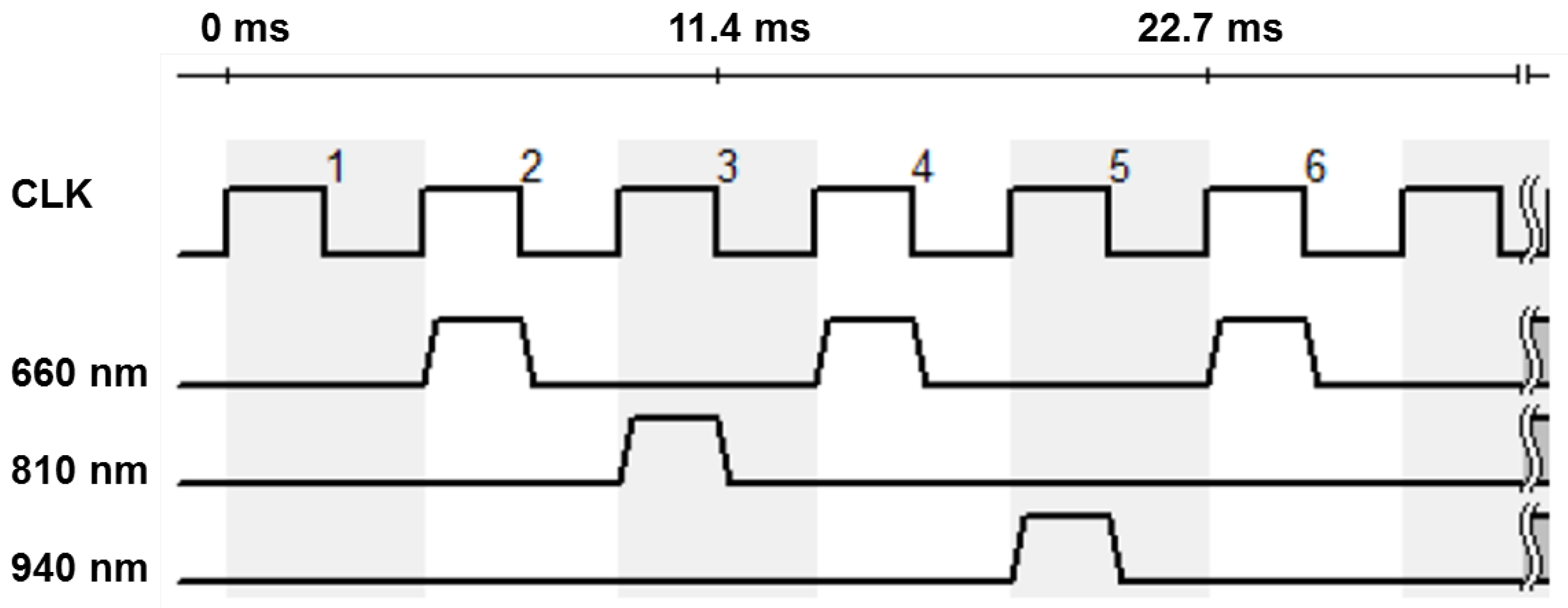
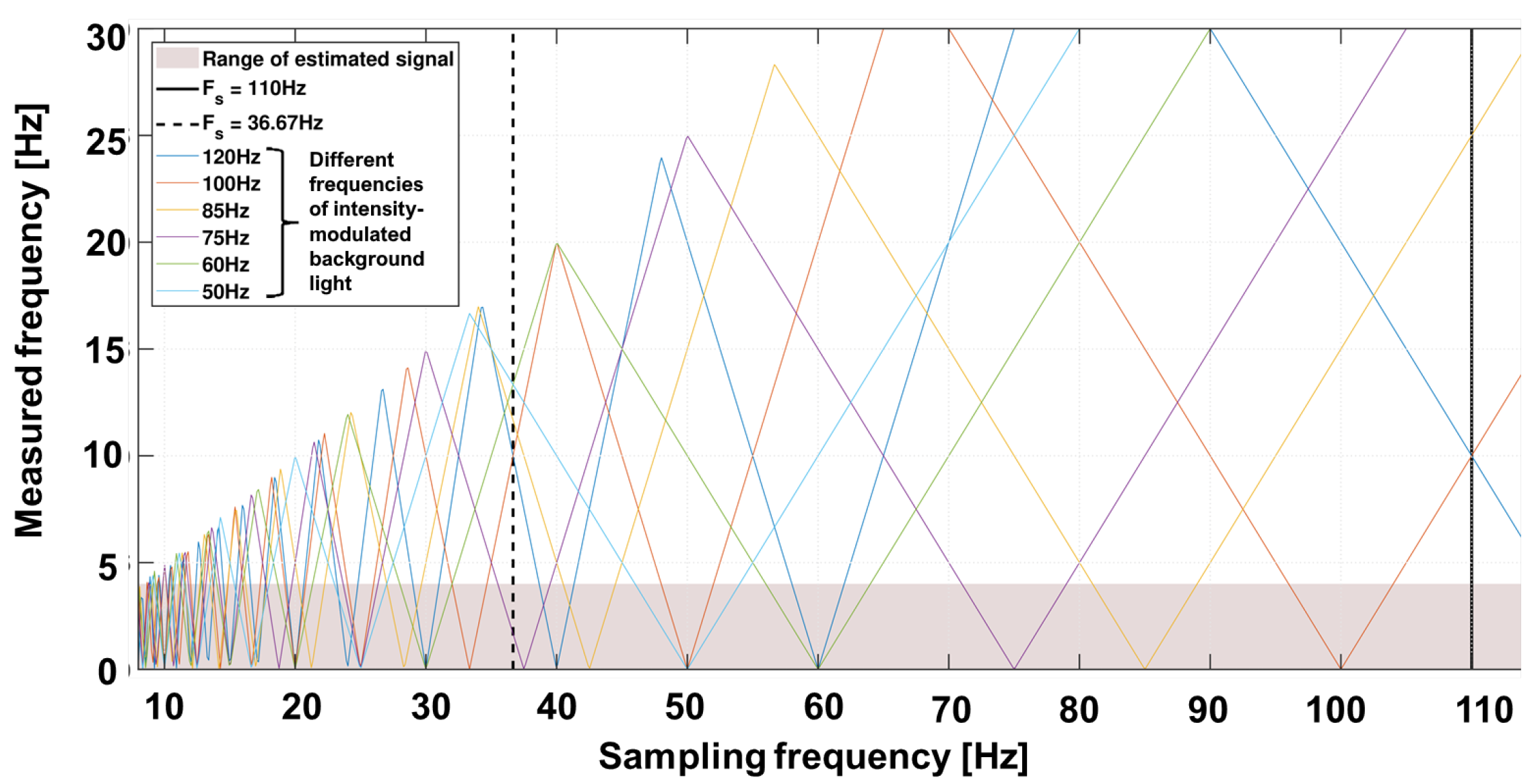
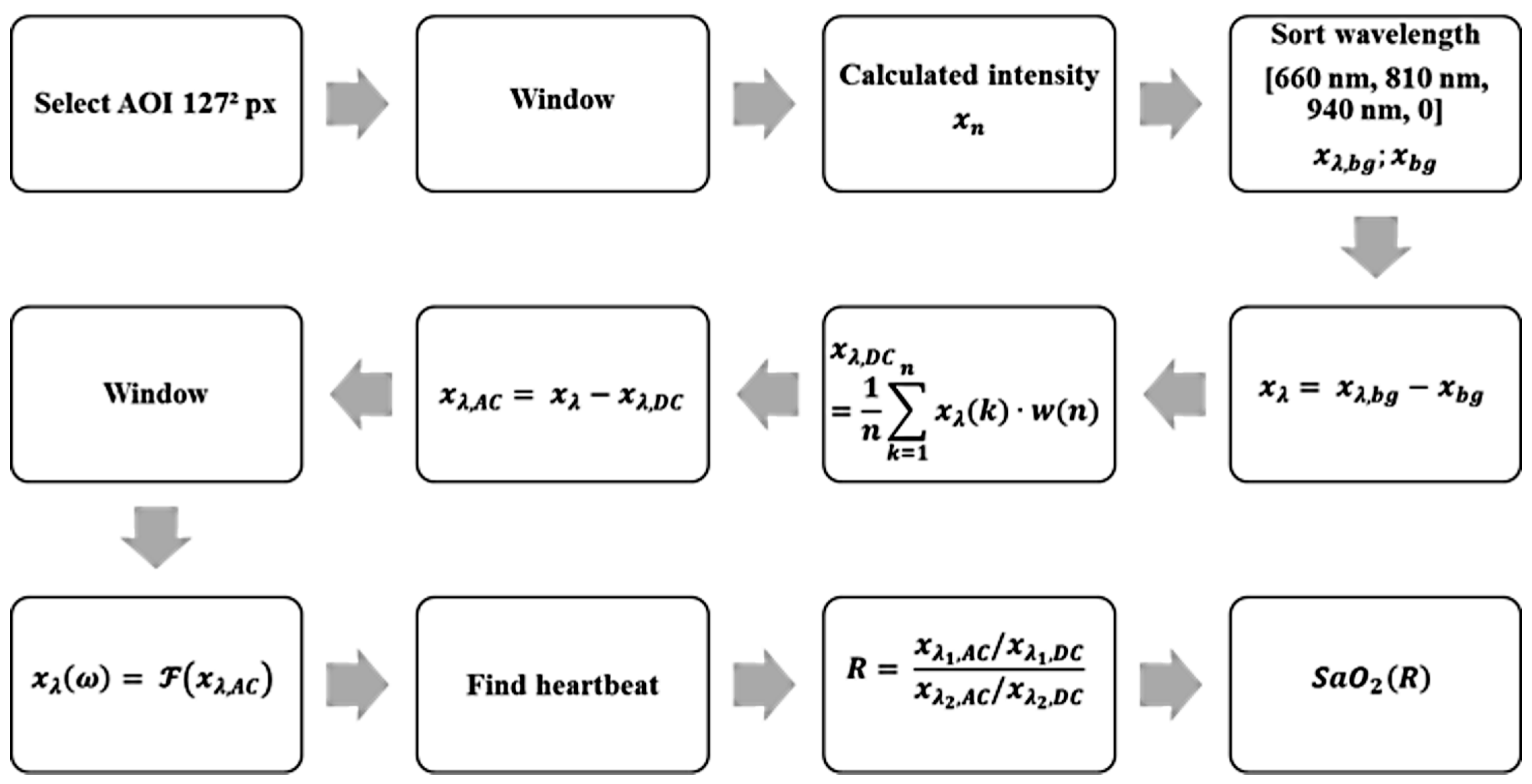
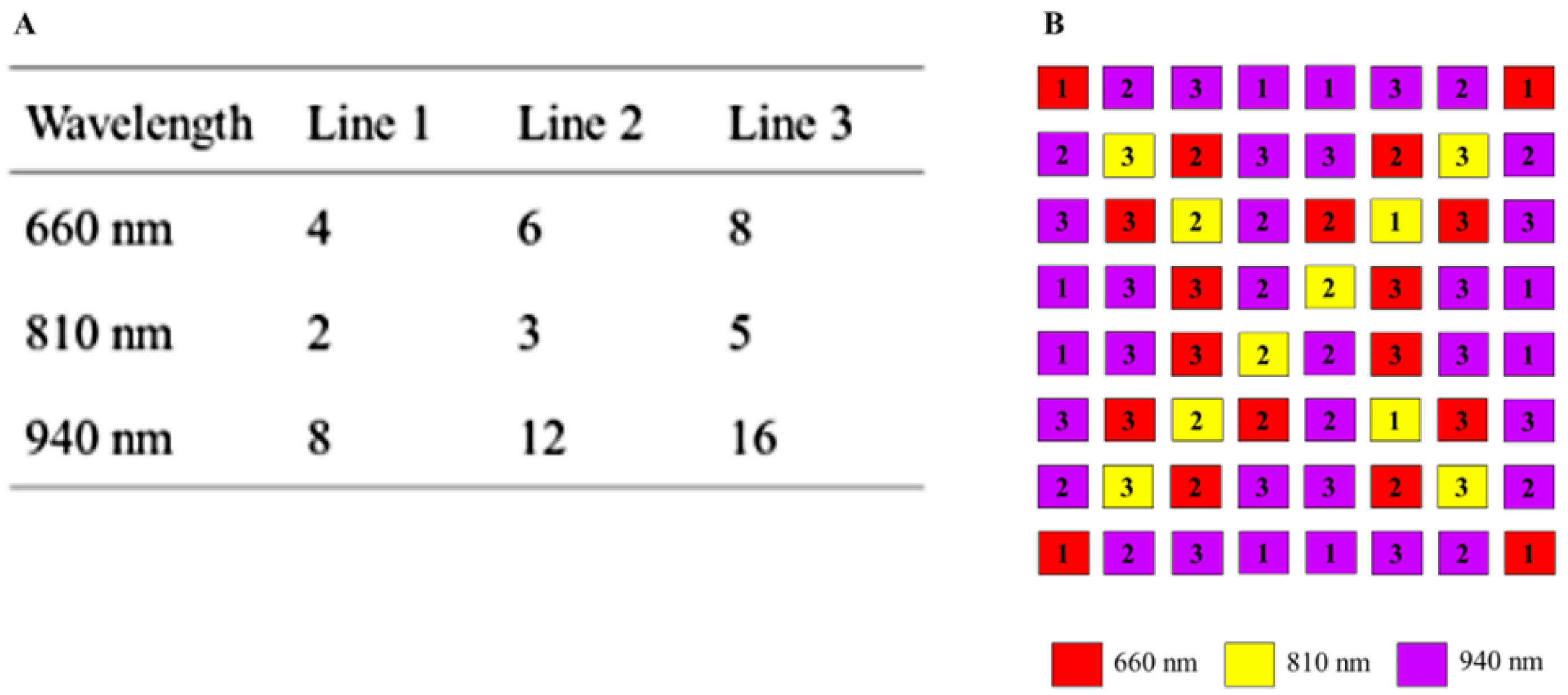
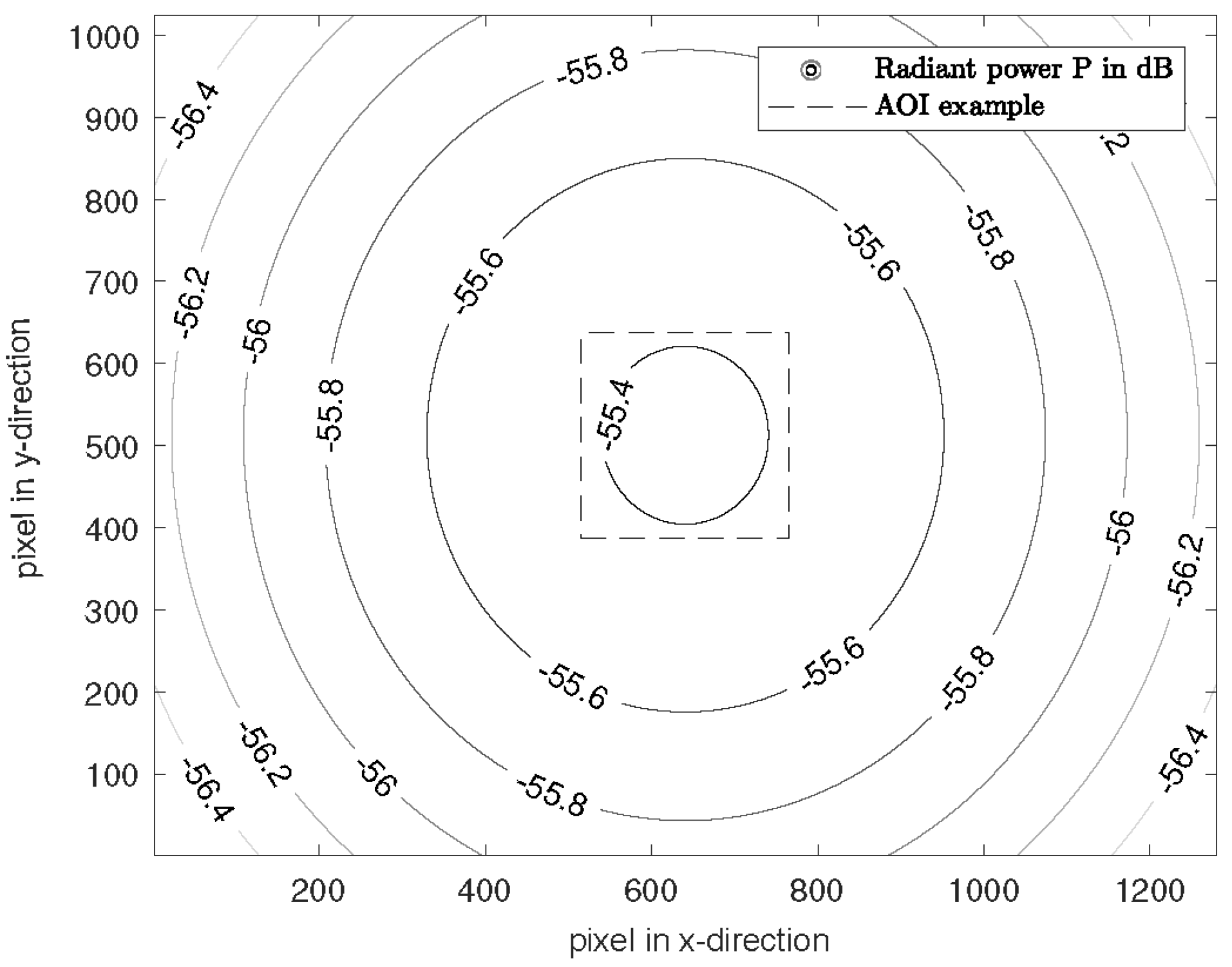
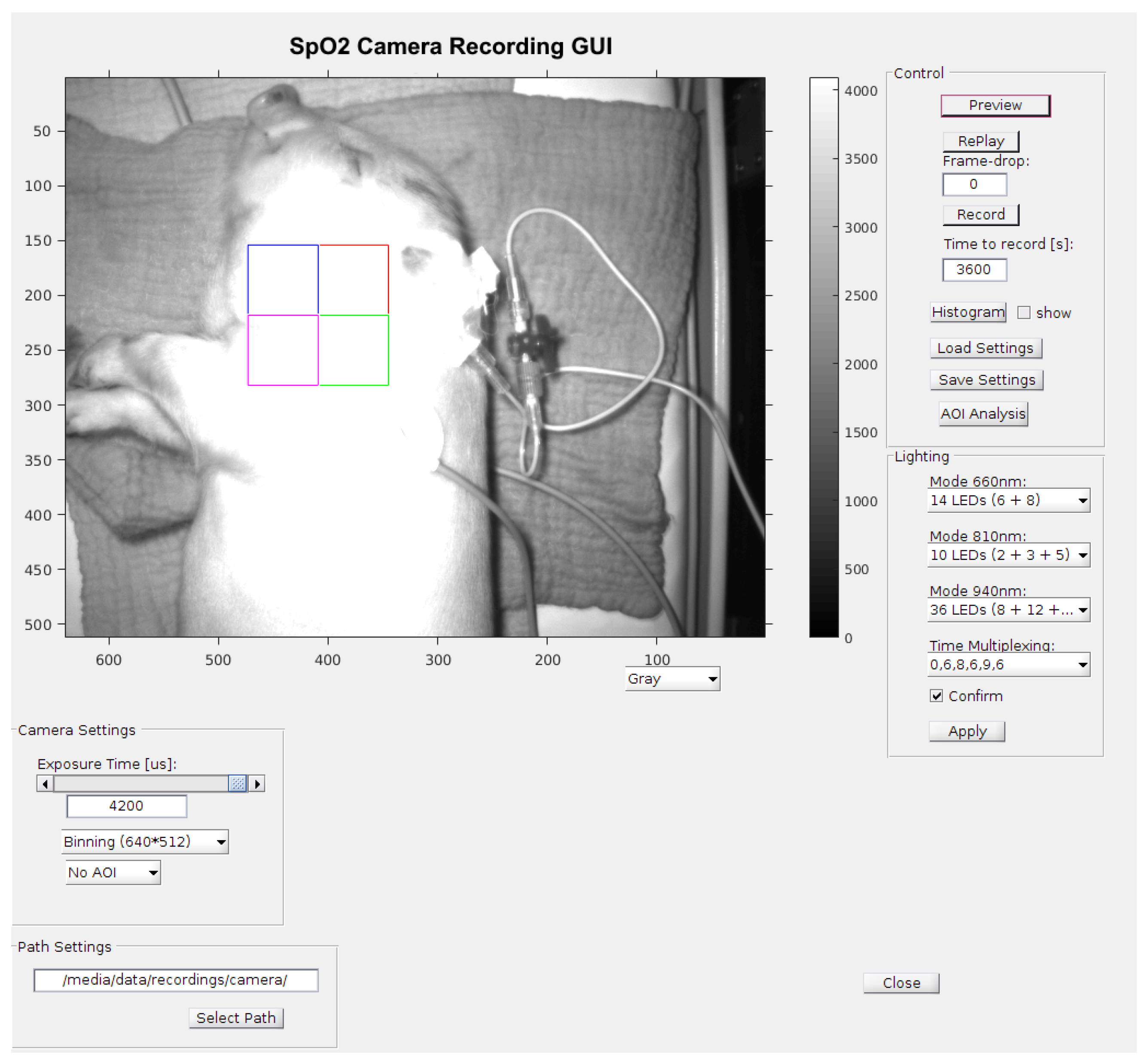





Disclaimer/Publisher’s Note: The statements, opinions and data contained in all publications are solely those of the individual author(s) and contributor(s) and not of MDPI and/or the editor(s). MDPI and/or the editor(s) disclaim responsibility for any injury to people or property resulting from any ideas, methods, instructions or products referred to in the content. |
© 2024 by the authors. Licensee MDPI, Basel, Switzerland. This article is an open access article distributed under the terms and conditions of the Creative Commons Attribution (CC BY) license (https://creativecommons.org/licenses/by/4.0/).
Share and Cite
Thull, R.; Goedicke-Fritz, S.; Schmiech, D.; Marnach, A.; Müller, S.; Körbel, C.; Laschke, M.W.; Tutdibi, E.; Nourkami-Tutdibi, N.; Kaiser, E.; et al. Investigation of a Camera-Based Contactless Pulse Oximeter with Time-Division Multiplex Illumination Applied on Piglets for Neonatological Applications. Biosensors 2024, 14, 437. https://doi.org/10.3390/bios14090437
Thull R, Goedicke-Fritz S, Schmiech D, Marnach A, Müller S, Körbel C, Laschke MW, Tutdibi E, Nourkami-Tutdibi N, Kaiser E, et al. Investigation of a Camera-Based Contactless Pulse Oximeter with Time-Division Multiplex Illumination Applied on Piglets for Neonatological Applications. Biosensors. 2024; 14(9):437. https://doi.org/10.3390/bios14090437
Chicago/Turabian StyleThull, René, Sybelle Goedicke-Fritz, Daniel Schmiech, Aly Marnach, Simon Müller, Christina Körbel, Matthias W. Laschke, Erol Tutdibi, Nasenien Nourkami-Tutdibi, Elisabeth Kaiser, and et al. 2024. "Investigation of a Camera-Based Contactless Pulse Oximeter with Time-Division Multiplex Illumination Applied on Piglets for Neonatological Applications" Biosensors 14, no. 9: 437. https://doi.org/10.3390/bios14090437
APA StyleThull, R., Goedicke-Fritz, S., Schmiech, D., Marnach, A., Müller, S., Körbel, C., Laschke, M. W., Tutdibi, E., Nourkami-Tutdibi, N., Kaiser, E., Weber, R., Zemlin, M., & Diewald, A. R. (2024). Investigation of a Camera-Based Contactless Pulse Oximeter with Time-Division Multiplex Illumination Applied on Piglets for Neonatological Applications. Biosensors, 14(9), 437. https://doi.org/10.3390/bios14090437





